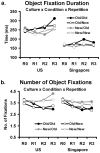Culture modulates eye-movements to visual novelty
- PMID: 20016829
- PMCID: PMC2790339
- DOI: 10.1371/journal.pone.0008238
Culture modulates eye-movements to visual novelty
Abstract
Background: When viewing complex scenes, East Asians attend more to contexts whereas Westerners attend more to objects, reflecting cultural differences in holistic and analytic visual processing styles respectively. This eye-tracking study investigated more specific mechanisms and the robustness of these cultural biases in visual processing when salient changes in the objects and backgrounds occur in complex pictures.
Methodology/principal findings: Chinese Singaporean (East Asian) and Caucasian US (Western) participants passively viewed pictures containing selectively changing objects and background scenes that strongly captured participants' attention in a data-driven manner. We found that although participants from both groups responded to object changes in the pictures, there was still evidence for cultural divergence in eye-movements. The number of object fixations in the US participants was more affected by object change than in the Singapore participants. Additionally, despite the picture manipulations, US participants consistently maintained longer durations for both object and background fixations, with eye-movements that generally remained within the focal objects. In contrast, Singapore participants had shorter fixation durations with eye-movements that alternated more between objects and backgrounds.
Conclusions/significance: The results demonstrate a robust cultural bias in visual processing even when external stimuli draw attention in an opposite manner to the cultural bias. These findings also extend previous studies by revealing more specific, but consistent, effects of culture on the different aspects of visual attention as measured by fixation duration, number of fixations, and saccades between objects and backgrounds.
Conflict of interest statement
Figures




Similar articles
-
Cultural variation in eye movements during scene perception.Proc Natl Acad Sci U S A. 2005 Aug 30;102(35):12629-33. doi: 10.1073/pnas.0506162102. Epub 2005 Aug 22. Proc Natl Acad Sci U S A. 2005. PMID: 16116075 Free PMC article.
-
Cultural variations in global and local attention and eye-movement patterns during the perception of complex visual scenes: Comparison of Czech and Taiwanese university students.PLoS One. 2020 Nov 16;15(11):e0242501. doi: 10.1371/journal.pone.0242501. eCollection 2020. PLoS One. 2020. PMID: 33196671 Free PMC article.
-
Eye movements during information processing tasks: individual differences and cultural effects.Vision Res. 2007 Sep;47(21):2714-26. doi: 10.1016/j.visres.2007.05.007. Epub 2007 Jul 5. Vision Res. 2007. PMID: 17614113 Free PMC article.
-
A physiological perspective on fixational eye movements.Vision Res. 2016 Jan;118:31-47. doi: 10.1016/j.visres.2014.12.006. Epub 2014 Dec 20. Vision Res. 2016. PMID: 25536465 Free PMC article. Review.
-
Culture sculpts the perceptual brain.Prog Brain Res. 2009;178:95-111. doi: 10.1016/S0079-6123(09)17807-X. Prog Brain Res. 2009. PMID: 19874964 Review.
Cited by
-
Performance deficits in a voluntary saccade task in Chinese "express saccade makers".PLoS One. 2012;7(10):e47688. doi: 10.1371/journal.pone.0047688. Epub 2012 Oct 16. PLoS One. 2012. PMID: 23091639 Free PMC article.
-
Cultural diversity and saccade similarities: culture does not explain saccade latency differences between Chinese and Caucasian participants.PLoS One. 2014 Apr 7;9(4):e94424. doi: 10.1371/journal.pone.0094424. eCollection 2014. PLoS One. 2014. PMID: 24709988 Free PMC article.
-
Head-Eye Coordination Increases with Age and Varies across Countries.Optom Vis Sci. 2015 Nov;92(11):1103-12. doi: 10.1097/OPX.0000000000000709. Optom Vis Sci. 2015. PMID: 26421683 Free PMC article.
-
Visual Attention to Novel Products - Cross-Cultural Insights From Physiological Data.Front Psychol. 2022 Sep 8;13:840862. doi: 10.3389/fpsyg.2022.840862. eCollection 2022. Front Psychol. 2022. PMID: 36160534 Free PMC article.
-
Cultural adaptation of visual attention: calibration of the oculomotor control system in accordance with cultural scenes.PLoS One. 2012;7(11):e50282. doi: 10.1371/journal.pone.0050282. Epub 2012 Nov 19. PLoS One. 2012. PMID: 23185596 Free PMC article.
References
-
- Masuda T, Nisbett RE. Attending holistically versus analytically: Comparing the context sensitivity of japanese and americans. J Pers Soc Psychol. 2001;81(5):922–934. - PubMed
-
- Miyamoto Y, Nisbett RE, Masuda T. Culture and the physical environment: Holistic versus analytic perceptual affordances. Psychol Science. 2006;17(2):113–119. - PubMed
-
- Nisbett RE. The geography of thought: How Asians and Westerners think differently – And why. New York; Free Press 2003
-
- Nisbett RE, Peng K, Choi I, Norenzayan A. Culture and systems of thought: Holistic versus analytic cognition. Psychol Rev. 2001;108(2):291–310. - PubMed
Publication types
MeSH terms
Grants and funding
LinkOut - more resources
Full Text Sources

